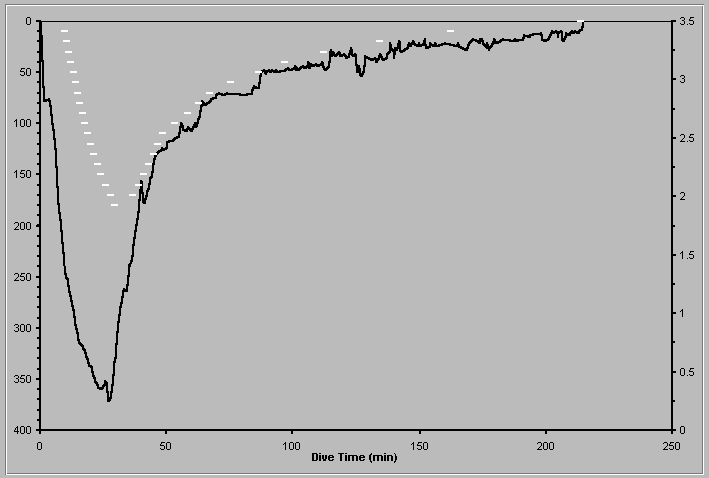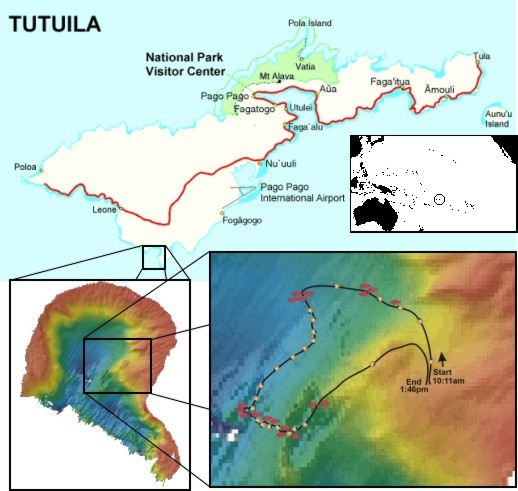
Solid line indicates depth, dashes ("-") indicate decompression ceilings.
Log Report for Submitted by Richard Pyle |
| Due to unfavorable weather conditions, we were only able to make a single deep dive within the Fagatele Bay National Marine Sanctuary during this expedition. Fortunately, that single dive proved to be enormously successful, both from an ichthyological perspective, and from a diving logistics perspective. Our plan was to do an initial reconnaissance along the base of an underwater peninsula that extends southward from the east side of the bay (see Bathymetry Map). Because the entire dive was planned for inside of the bay, we did not take any specimen collection equipment. I brought along my Sony® VX-1000 video camera inside an Amphibico® underwater housing, specially modified to withstand excess depth. I let the video camera run throughout most of the dive, and attempted to capture video images of the interesting geological features and marine life that we encountered. Although the still images captured from this video leave much to be desired, they do provide some visual representation of what we saw during the dive (see Dive Path Page). |
| Dive Number 1 of 1 |
| Divers: | Richard Pyle, John Earle |
 Solid line indicates depth, dashes ("-") indicate decompression ceilings. |
| Max. Depth: 372 feet (113 meters) | Time: 10:11am | Duration: 3 hr, 34 min |
| Location: | American Samoa; Tutuila; E side of Fagatele Bay. |
| Marine Life: | A complete lisiting of our discoveried made during this dive is available on the New Discoveries Page. In Summary, we observed at least 12 undescribed fish species, 17 new records for Samoa, and a number of additional new records for Fagatele Bay. |
| Remarks: | We began our dive at the mooring buoy on the east side of Fagatele Bay. We descended down slope and out into the sand, towards the center of the bay. We eventually veered towards the south and continued further downslope. We then moved back eastward until we joined up with the start of the deeper of two vertical drop-offs on the west flank of the underwater peninsula, on the east side of the Bay. We followed the deeper drop-off southward, then ascended. The top of the deeper wall is at a depth of about 280 feet (85 meters), above which is a steep sandy slope that extends to the base of the shallower drop-off, at a depth of about 250 feet (76 meters). The top of this drop-off is at a depth of approximately 130 feet (40 meters), and is heavily populated with fishes. Decompression was conductded during a gradual swim back towards the mooring bouy line, and thereafter underneath the support boats. |

| Disclaimer: The dive referred to on this web page is of an experimental nature, and all persons involved with this dive are fully cognizant of the associated risks. The decompression practices followed on this dive are derived from published information, in conjunction with the many years of extensive experience of the divers involved. These practices have not been tested under controlled conditions, and may not work equally well for all divers. Kids, don't try this at home!! |
| Fagatele Bay
Expedition Return to the Fagatele Bay expedition home page.
|